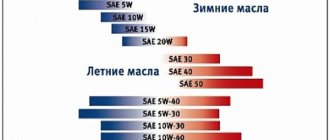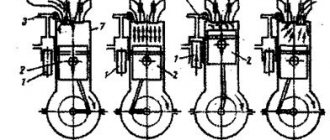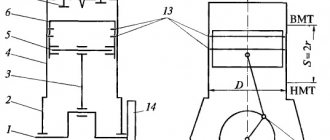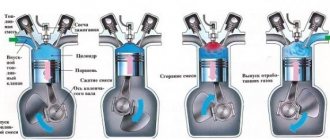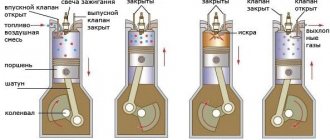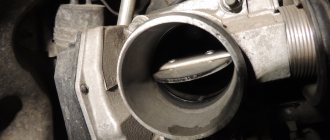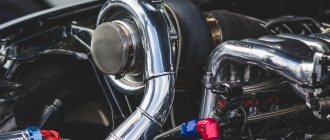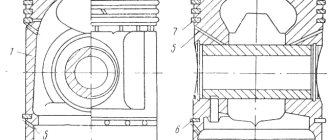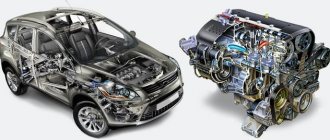What are dead spots and engine cycles?
The number of stages included in one working cycle of an internal combustion engine (ICE) is usually calculated based on the number of piston strokes in the cylinder. These stages are called engine strokes. The stroke of the piston is directly determined by its movement from one extreme point to another. They are called dead, because if the piston stops at such a point, it will not be able to start moving without external influence. In simple words, dead points are positions at which the movement in the current direction of the piston stops and it begins to reverse.
Classification of gasoline engines:
By number of cylinders
– single-cylinder, double-cylinder, multi-cylinder;
By cooling system
– engines with liquid and air CO.
By type of lubrication
– mixed (the fuel mixture is mixed with oil), separate type (oil is poured into the crankcase).
By type of fuel used:
gasoline or multi-fuel.
According to the degree of compression.
The engines are divided into high (E=12…18) and low (E=4…9) compression engines.
According to the method of mixture formation
- are divided into engines with external mixture formation, the fuel mixture is prepared outside the engine cylinders (gas and carburetor), and engines with internal mixture formation (injection - the working mixture is formed inside the cylinders).
By placement of cylinders
– V-shaped, in which the cylinders are located at an angle (if the angle is 180 degrees, then the engine is opposed [with opposing cylinders]). In in-line engines, the cylinders are arranged vertically or horizontally in a single row.
According to the method of carrying out the work cycle
– two-stroke and four-stroke.
Two-stroke engines
have more power per unit volume, but lose in efficiency.
Therefore, they have found their application where compactness is important rather than efficiency (motorcycles, motor boats, chainsaws and other motorized tools). Four-stroke engines
dominate the rest of the transportation industry. An interesting fact is that two-stroke diesel engines do not have many of the disadvantages of two-stroke gasoline engines, but are used mainly on large ships (sometimes on diesel locomotives and trucks).
By rotation frequency:
low-speed, high-speed, high-speed.
By purpose:
stationary, ship, auto-tractor, aviation, diesel locomotive, etc.
By fuel supply method:
there are atmospheric engines in which fuel is supplied due to the difference in atmospheric pressure and pressure inside the engine during the suction stroke of the piston; In supercharged engines, the fuel mixture is supplied to the cylinder under pressure, which is maintained by a turbocharger, to increase engine power.
How does a four stroke engine work?
Structurally, the working cycle of a typical four-stroke unit is ensured by the operation of the following elements:
- cylinder;
- piston - performs reciprocating movements inside the cylinder;
- intake valve – controls the process of supplying the air-fuel mixture to the combustion chamber;
- exhaust valve – controls the process of exhaust gases expelling from the cylinder;
- spark plug – ignites the resulting air-fuel mixture;
- crankshaft;
- camshaft - controls the opening and closing of valves;
- belt or chain drive;
- crank mechanism - translates the movement of the piston into rotation of the crankshaft.
Operating cycle of a four-stroke engine
The operating cycle of such a mechanism consists of four strokes, during which the following processes are implemented:
- Intake (fuel and air injection). At the beginning of the cycle, the piston is at TDC. At the moment when the crankshaft begins to rotate, it acts on the piston and moves it to BDC. This leads to the formation of vacuum in the cylinder chamber. The camshaft acts on the intake valve, gradually opening it. When the piston is in its extreme position, the valve is completely open, resulting in intense injection of fuel and air into the cylinder chamber.
- Compression (increasing the pressure of the combustible mixture). In the second stage, the piston begins to move back to the top dead center of the compression stroke. The crankshaft makes another turn and both valves are completely closed. The internal pressure increases to 1.8 MPa and the temperature of the combustible mixture rises to 600 C°.
- Expansion (working stroke). When the piston reaches the top position in the combustion chamber, the maximum compression is set to 5 MPa and the spark plug is fired. This leads to combustion of the mixture and an increase in temperature to 2500 C°. Pressure and temperature lead to an intense impact on the piston, and it begins to move back to BDC. The crankshaft makes another turn, and thus the thermal energy is converted into useful work. The camshaft opens the exhaust valve, and when the piston reaches BDC, it is fully open. As a result, the exhaust gases begin to gradually leave the chamber, and the pressure and temperature decrease.
- Exhaust (removal of exhaust gases). The engine crankshaft turns and the piston begins to move to the top point. This leads to the expulsion of exhaust gases and an even greater decrease in temperature and a decrease in pressure to 0.1 MPa. Next, a new cycle begins, during which these processes are repeated again.
During each stroke, the engine crankshaft rotates 180°. During a full working cycle, the crankshaft rotates 720°.
The four-stroke engine has become widespread. It can work with both gasoline and diesel fuel. The difference between the operating cycle for a diesel engine is that the ignition of the air-fuel mixture does not occur from a spark, but from high pressure and temperature at the end point of the compression stroke.
The principle of operation of a carburetor engine
The principle of operation of a carburetor engine is relatively simple and consists of four strokes, which coincide with the movement up and down in sequence one after another:
- The first stroke is intake; the intake valve opens and a new mixture from the power system is delivered to the cylinder.
- The second stroke is compression; The piston compresses the combustible mixture in the combustion chamber. All valves are closed.
- The third measure is expansion; the compressed combustible mixture from the spark plug ignites. The mixture burns quite quickly with a constant volume, which corresponds to the volume of the compression chamber itself. This is the main characteristic of the operation of a carburetor engine. When burned out, gases are formed that move the piston downward and transmit movement to the crankshaft.
- The fourth stroke is injection; the crankshaft rotates and expels exhaust gases from the cylinder through the slightly open exhaust valve.
This completes one working cycle of the carburetor engine.
During the first stroke, the intake valve is already open when the piston approaches and, due to the high speed of the piston, the working mixture moves towards the cylinder and for some more time when the piston rises in the second stroke.
A spark ignites the working mixture before high pressure builds up in the cylinder. In the fourth stroke, the valve releases spent vapors, which cleans the cylinder even before the piston approaches. However, the release of gases does not stop even after the piston approaches. Then a new portion of the working mixture is launched, which again passes into the cylinder.
It follows that during operation between the first and fourth strokes, the intake and exhaust valves open simultaneously, that is, the valves overlap. During the moment of overlap, the cylinder is cleaned and a vacuum occurs in it, which helps to more efficiently fill the cylinder with the combustible mixture during the first stroke.
In such an engine, the external formation of the working mixture occurs with its compression and forced ignition. Today, gasoline is more often used as a fuel, but they can do their job perfectly on gas.
Diesel engines are also popular, where ignition occurs from compression; their operating principle depends on heating the gas during compression. As compression increases, temperature also rises. At this time, fuel is injected into the combustion chamber through the nozzle, which is ignited and the resulting gases move the piston. Fuel combustion occurs after the piston begins to move.
The operating principle of a single-cylinder engine is indicated above, but it is not capable of creating conditions for continuous rotation at the same speed. The expanded gases act on the crankshaft for 1/4 of its revolution, the remaining ¾ of the revolution of the piston movement occurs by inertia.
To eliminate this shortcoming, engines are made multi-cylinder, which contributes to the most uniform rotation and constant torque.
Features of two-stroke engines
The basis of how a two-stroke engine differs from a four-stroke engine can be called the fact that in the first, the crankshaft makes two revolutions in one working cycle, and in the second, the entire working cycle fits into one revolution of the crankshaft (360°). The piston makes only two strokes. The processes occurring in the combustion chamber during the operating cycle of a two-stroke engine do not differ from four-stroke engines, but the intake of the combustible mixture and the exhaust gases are carried out simultaneously with the compression and expansion strokes.
The process of simultaneous removal of exhaust gases and injection of fresh charge into the cylinder, which occurs in a two-stroke engine, is called purging.
The operating principle of the simplest two-stroke engine is as follows:
- Compression stroke . At the beginning of the cycle, the piston is at BDC and moves to the TDC position on the compression stroke. In this case, the purge (inlet) window is blocked, and then the exhaust channel. At the moment when the piston closes the exhaust window, compression of the combustible mixture begins, and a vacuum occurs in the space under the piston. This ensures that fuel is forced into the chamber through the slightly open intake valve.
- Expansion stroke (power stroke). When the piston approaches TDC, the spark plug fires and the mixture ignites. This provokes a sharp increase in pressure and temperature, as a result of which the piston begins to move downwards. Thus, the gases perform useful work, and the piston, when moving to BDC, increases the compression of the air-fuel mixture. As pressure increases, the valve begins to close and prevents the combustible mixture from entering the intake manifold. When the piston reaches the exhaust window, the latter opens and exhaust gases are removed into the exhaust system. The pressure in the chamber decreases, and further movement of the piston opens the purge channel and the air-fuel mixture is supplied to the chamber, displacing the exhaust gases.
The operation process of a diesel internal combustion engine
As the name suggests, the working cycle of a four-stroke internal combustion engine consists of 4 strokes: intake, compression, expansion and exhaust. Four strokes correspond to two revolutions of the crankshaft and four strokes of the piston. The stroke of the piston is its movement from top dead center (TDC) to bottom dead center (BDC) or vice versa. This is one of the most important characteristics of the engine, which determines the degree of compression of the fuel mixture, and therefore the engine power.
The first stroke - the intake stroke - in a diesel engine is the intake of air through the opening intake valve. The piston moves from TDC to BDC, creating a vacuum in the combustion chamber, which helps draw air into the cylinder.
The compression stroke is the process of compressing air as the piston moves from BDC to TDC with the valves closed. At the same time, the volume in the combustion chamber decreases, the pressure increases and the temperature rises. A little before the piston reaches its upper position, diesel fuel is injected through the nozzle. When exposed to hot air, it ignites.
The expansion stroke (power stroke) is characterized by a sharp increase in temperature and pressure due to fuel combustion. Gases put pressure on the piston, moving it from TDC to BDC, which is the main driving force of the engine.
Exhaust stroke – removal of exhaust gases from the combustion chamber through the exhaust valve. The piston rises to TDC, pushing combustion products out.
After the exhaust stroke comes the intake stroke again, and so on in a circle.
The operation of all 4-stroke engines is the same, whether it is a diesel engine or a gasoline engine.
Working cycle of a four-stroke diesel engine
Good afternoon. Let's consider
, what is happening, what
is happening
in one of the cylinders
running
diesel engine.
Intake is the first stroke.
Piston
moves down and, like a pump, raises the vacuum.
Under the influence
of the pressure difference, clean
air
fills the cylinder.
The exhaust
valve is closed.
At the end of the stroke, closes
.
At the end of the stroke, the pressure in the cylinder is 0.09 MPa, and the temperature is 30-50 degrees.
Compression is the second step.
Piston
continues
moving
and moves up.
Two valves are closed
, so excess pressure is created and the temperature rises.
The temperature
reaches 600 degrees and
the pressure
reaches 4 MPa.
At the end
of diesel
is injected into the cylinder in
a finely atomized state
through an injector.
Small particles of fuel, coming into contact with hot compressed air and cylinder
, ignite and
most
of them burn out.
Expansion or working stroke is the third stroke.
The piston goes down. During this stroke the fuel
everything burns down.
The valves are closed during the working stroke. The temperature
of the gases during combustion reaches 2000 degrees, and
the pressure
rises to 8 MPa.
Under great pressure
As the expanding gases move,
the piston
moves downward and transmits the force it perceives through
rod
to the crankshaft, causing it to rotate.
At the end of the stroke the pressure
decreases to 0.4 MPa, and the temperature to 700
degrees
.
Release is the fourth beat.
Piston
moves up and
the outlet
valve opens.
The exhaust
gases are removed from
the cylinder
first under pressure, and then
the piston
pushes them out.
At the end of the beat the valve is released
closes and the intake
opens
.
The work cycle repeats
.
Subscribe
to the channel and
like
it!
Source
Working cycle of a four-stroke diesel engine
Unlike a carburetor engine, air and fuel are introduced separately into the diesel cylinder.
Intake stroke
The piston moves from T.M.T. to n.m.t. (Figure a), the intake valve is open, air enters the cylinder.
Compression stroke
Both valves are closed. The piston moves from ground level. to v.m.t. (Figure b) and compresses the air. Due to the high compression ratio (about 14...18), the air temperature becomes higher than the auto-ignition temperature of the fuel.
Drawing. Working cycle of a single-cylinder four-stroke diesel engine: a - intake stroke; b - compression stroke; c — expansion stroke; r — exhaust stroke
At the end of the compression stroke, with the piston position close to TDC, liquid fuel begins to be injected into the cylinder through the nozzle. The nozzle design ensures fine atomization of fuel in compressed air.
Fuel injected into the cylinder is mixed with heated air and remaining gases to form a working mixture. Most of the fuel ignites and burns, the pressure and temperature of the gases increase.
Expansion stroke
Both valves are closed. The piston moves from T.M.T. to n.m.t. (Figure c). At the beginning of the expansion stroke, the rest of the fuel is burned.
